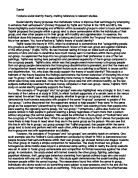The concepts of “in-groups” and “out-groups” were also highlighted very strongly; in fact, it was the basis of the Levine et al study in 2005, in which football supporters of a certain team at the venue were tested the extent they would help people, whether in-group or out-group. Levine wished to demonstrate how humans associate with people of the same “in-group” compared to people of the “out-group.” Levine discovered that the supporters tended to help people if they were “in the same group as the supporters” (determined by the jersey the “victim” was wearing) more than people who were wearing the opposing team’s jersey, the “out-group.” Furthermore, Levine also found out that people tended to help people in general wearing a jersey regardless of team more than a person without any jersey (the control people). This would be attributed to the in-group of “football fans” and the out-group of “non-football fans.” What is so significant of this study is that it shows that people are more likely to help those in need when they are in the same group as the person. We can see that this ties in with the in group / out group concept that Tajifel proposed; that people within the same group tend to bond and perform well with each other, while people on the other edges, who are not in the in-group are met with apprehension and dislike.
However, the concepts of “in-groups” and “out-groups” can certainly reach an extreme. One such example was the Robber’s Cave experiment conducted by Sherif in 1954 to demonstrate how people boosted their self-confidence within their own groups, yet showed hatred and disgust towards the other group; in merely a simple competition for resources. The study involved two groups of homogenous white middle class boys in a simulated camp setting, while in reality the camp scenario was set in order to foster group camaraderie and competition for limited resources against the other group. In conclusion, the study ended with hatred towards the other group, fighting, sabotage, psychical violence, theft, gang-type behaviour stemming from typical ordinary boys who one would not associate with any sort of mishap. Yet, this study again demonstrates the social bonding done between people within the same in-group. The researchers found that within the same in group, individuals who alone would not do something were subject to peer-pressure, and in the end did the same actions as their members, such as swimming. This study also demonstrated the effectiveness of in-group and out-group behaviour, in which the scenario caused ordinary boys to turn into literally over the matter of the week, street thugs plotting violence, attrition, and revenge against the other “belligerent team.” Yet, this study is quite the hallmark of social identity theory – that people favour their own in-group members compared to out-group members.
One other such study with violent results was the Stanford Prison Experiment, which primarily examined the psychological effects of having control / the lack of control; but also examined in-group relationships; this time being the prisoner group or the guard group. Participants were randomly assigned to either the guard role or the prisoner role. Yet, the results that occurred from this experiment were shocking to the world. The participants simply over adapted to their roles; the guards were simply despots who resorted to abuse, authoritarian measures to control the prisoners. The majority prisoners themselves passively did not strike against the abuse, and allowed themselves to be ostracized. The results of this study also demonstrates the by-stander effect within the group; that the “good” guards who may not have wanted to “abuse” prisoners played along because they wanted to feel a part of the group. Conversely with the prisoners, most prisoners refused preferential treatment because they felt that they were part of the “group,” in this case prisoners, and that accepting higher standards would be unfair to the group. Hence, we see that these human behaviours all attempt to explain the theory of social identity.
Cialdini and other researchers in 1976 also demonstrated this theory with their study amongst college football supporters. They found out that after a match; if their team won, they would be highly likely to wear college insignia and apparel. Yet, if their team lost that match, they were much less likely, How does that relate to the theory however? It relates because of the human need for positive self esteem; one would be much more positive towards something that he or she represents within “the group.” Hence, Cialdini’s study does corroborate social identity theory.
Does the social identity theory really work out in society? To quite a great extent; yes. Tajifel’s argument is that we bond well with our own group and go against the other group for the sake of our own self-esteem; other researchers’ studies have corroborated that. However, the theory itself is not without its weaknesses and limitations. The theory does manage to describe, yet cannot actually predict the human behaviour. In other words, one can tell what social behaviours groups and individuals are going through, but cannot predict the actions that occur later. Another issue is that the theory reduces the individual into isolation, and does not address the environmental factors that also play a role with behaviour; not to even mention social factors. Yet, social identity theory is in general, rather well supported.
Daniel handwrote this paper with only the aid of notes within one hour.
May 31, 2012
Start time:
End time:
_______________________







